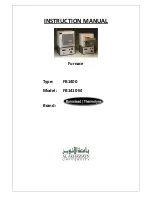
935SA: Installation, Start-up, Operating and Service Maintenance Instructions
Manufacturer reserves the right to change, at any time, specifications and designs without notice and without obligations.
33
A14546
Fig. 46 – Near Furnace Vent Connections
Install the Vent and Combustion Air Pipes
With the furnace installed in the required position, remove the desired
knockouts from the casing. It will be necessary to remove one knockout
for the vent pipe and the other knockout for the combustion air
).
Use a flat blade screwdriver and tap on the knockout on opposite sides,
where the knockout meets the casing. Fold the knockout down with duct
pliers and work the knockout back and forth until it is removed. Trim
any excess metal from the knockout with tin snips.
The vent elbow can be rotated to the required location on the casing if
necessary
(see
). To rotate the vent elbow:
1. Loosen the clamp on the inlet of the vent elbow attached to the
inducer.
2. Rotate the vent elbow to the required position. There are rounded
notches on the vent elbow to align it with the inducer housing for
each orientation.
3. Tighten the clamp around the vent elbow. Torque the clamp to 15
).
Installing the Vent Pipe Adapter and Combustion Air
Pipe Adapter
NOTE:
The rubber coupling that attaches to the vent pipe adapter must
be used. The adapter seals the vent pipe to the casing and reduces the
strain on the vent elbow attached to the inducer.
1. Apply the gaskets to the vent pipe and combustion air pipe
adapters. If supplied, remove and discard round center “slug” from
interior of gasket (see
).
NOTE:
The vent pipe adapter can be distinguished from the inlet pipe
adapter by the absence of an internal pipe-stopping ring. The vent pipe
can pass through the vent pipe adapter; it cannot pass through the inlet
pipe adapter.
2. Align the screw holes in the plastic vent pipe adapter with the
dimples in the casing.
3. Pilot drill the screw holes for the adapter in the casing and attach
the vent pipe adapter to the furnace with sheet metal screws
4. Slide the end of the rubber vent coupling with notches in it over the
standoffs on the vent pipe adapter.
5. Insert a length of vent pipe through the coupling into the outlet of
the vent elbow.
6. Tighten the clamp around the outlet of the vent elbow. Torque the
clamp to 15 lb-in.
A13074
Fig. 47 – Vent Coupling and Adapter with Gaskets
A210034
Fig. 48 – Inducer Vent Elbow
Install the remaining vent and combustion air pipes as shown below. It is
recommended that all pipes be cut, prepared, and pre-assembled before
permanently cementing any joint.
1. Working from furnace to outside, cut pipe to required length(s).
2. De-burr inside and outside of pipe.
3. Chamfer outside edge of pipe for better distribution of primer and
cement.
4. Complete the vent and combustion air pipe installation by
connecting the concentric vent or by installing the required
termination elbows (see
).
For Ventilated Combustion Air Termination (see
).
5. Clean and dry all surfaces to be joined.
6. Check dry fit of pipe and mark insertion depth on pipe.
WARNING
!
CARBON MONOXIDE POISONING HAZARD
Failure to follow this warning could result in personal injury or death.
To route the vent pipe and combustion air pipe through the furnace, the
manufacturer supplied kit must be used. Failure to properly seal the
blower compartment from the furnace vestibule could result in the
circulation of carbon monoxide throughout the structure. The vent pipe
and combustion air pipe must be a continuous pipe while passing
through the blower compartment. Seals supplied in this kit must be
installed per the instructions provided. Follow all procedures outlined
in these instructions.
WARNING
!
CARBON MONOXIDE POISONING HAZARD
Failure to follow this warning could result in personal injury or death.
DO NOT
use cement to join polypropylene venting systems. Follow
the polypropylene venting system manufacturer’s instructions for
installing polypropylene venting systems.
Avoid short horizontal offsets with 90
deg. Elbows. Short offsets can be
difficult to slope and may trap con-
densate.
Use 45 deg. Elbows where
possible, to ensure conden-
sate drainage.
Slope vent pipe back to the
furnace at least ¼” per foot
NOTICE
!
The following instructions are for PVC/ABS DWV vent piping only.
DO NOT USE THESE TECHNIQUES FOR POLYPROPYLENE
VENT PIPING SYSTEMS. See the polypropylene vent system
manufacturer’s instructions for installing polypropylene venting
systems.
Attach gaskets to vent pipe and
combustion air adapters.
Vent Coupling and Adapter
















































